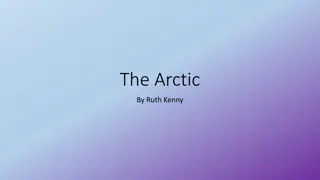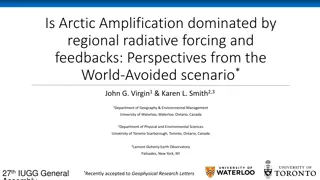Arctic Climate Outlook: Summer 2020 & Winter 2020-2021 Highlights
In Summer 2020, Arctic experienced above-normal temperatures, wetter conditions in most areas except Siberia, and record-low sea-ice extent. Winter 2020-2021 forecasts above-normal temperatures, wetter conditions, and delayed freeze-up in certain regions.
Download Presentation

Please find below an Image/Link to download the presentation.
The content on the website is provided AS IS for your information and personal use only. It may not be sold, licensed, or shared on other websites without obtaining consent from the author.If you encounter any issues during the download, it is possible that the publisher has removed the file from their server.
You are allowed to download the files provided on this website for personal or commercial use, subject to the condition that they are used lawfully. All files are the property of their respective owners.
The content on the website is provided AS IS for your information and personal use only. It may not be sold, licensed, or shared on other websites without obtaining consent from the author.
E N D
Presentation Transcript
Consensus statement Summary and highlights (1/2) Overall summary: Summer 2020: The combination of an Arctic meridional atmospheric circulation (north-south) and high ocean surface heating between June and August 2020 was the main driver of this past season s temperature, precipitation and sea ice anomalies Winter 2020-2021: Above normal temperatures forecast for all Arctic regions between November 2020 and December 2021 will continue to have implications for sea-ice over that time period Temperature highlights: Summer 2020: The summer 2020 average surface air temperatures were above normal for most of the Arctic domain Eastern and Western Siberia experienced several heat waves Record high temperature of 38 C at Verkhoyansk on 20 June, 2020 Winter 2020-2021: Above normal temperatures are expected to continue across the majority of the Arctic this winter
Consensus statement Summary and highlights (2/2) Precipitation highlights: Summer 2020: Wetter than average conditions between June and August 2020 were observed across the majority of the Arctic, except for Eastern and Western Siberia where drier than average conditions were observed. Winter 2020-2021: Wetter than normal conditions are expected across the majority of the Arctic region this winter. Sea-ice highlights: Summer 2020: The Northern Hemisphere September 2020 minimum sea- ice extent was the 2ndlowest since 1979, with varying ice cover across the Arctic: Eurasian seas and the Northern Sea Route: completely ice free Beaufort Sea and the Canadian Archipelago: near-normal conditions Winter 2020-2021: Later than normal fall freeze-up is expected for Baffin Bay, East Siberia, and the Kara, Labrador, and Laptev Seas; near normal to early freeze-up is expected for all other regions. Below to near normal 2021 maximum sea ice extent are forecast for majority of the Arctic.
Next slide provides a different layout for the first slide























